|
Wednesday, Sept. 10
3:30 p.m.
DIRECTOR'S COFFEE BREAK - 2nd Flr X-Over
THERE WILL BE NO FERMILAB COLLOQUIUM THIS WEEK
4 p.m.
Special Seminar - One West
Speaker: L. E. Temple, Jr., Argonne National Laboratory/Fermilab
Title: Critical Decisions on DOE Projects: Fermilab Implementation of Project Management
Thursday, Sept. 11
THERE WILL BE NO PHYSICS AND DETECTOR SEMINAR THIS WEEK
2:30 p.m.
Theoretical Physics Seminar - Curia II
Speaker: I. Low, Northwestern University/Argonne National Laboratory
Title: Kaluza-Klein Parity in Warped Extra Dimensions
3:30 p.m.
DIRECTOR'S COFFEE BREAK - 2nd Flr X-Over
THERE WILL BE NO ACCELERATOR PHYSICS AND TECHNOLOGY SEMINAR TODAY
Click here for NALCAL,
a weekly calendar with links to additional information. |
|
Wednesday, Sept. 10
- *Beef barley
- Fish & chips
- *Smart cuisine: Caribbean grill
- Salmon liver w/onions
- Beef & cheddar panini w/sautéed onions
- Assorted slice pizza
- Cavatappi pasta w/Italian sausage & tomato Ragu
*Carb Restricted Alternative
Wilson Hall Cafe Menu |
|
Wednesday, Sept. 10
Lunch
- Chile reno with a tomato sauce
- Rice & beans ~ pico de gallo
- Cold lime soufflé
Thursday, Sept. 11
Dinner
- Closed
Chez Leon Menu
Call x4598 to make your reservation.
|
|
|
First beam for Large Hadron Collider
Washington, D.C. - An international collaboration of scientists today sent the first beam of protons zooming at nearly the speed of light around the world's most powerful particle accelerator-the Large Hadron Collider (LHC)-located at the CERN laboratory near Geneva, Switzerland. The U.S. Department of Energy (DOE) and the National Science Foundation (NSF) invested a total $531 million in the construction of the accelerator and its detectors, which scientists believe could help unlock extraordinary discoveries about the nature of the physical universe.
Celebrations across the U.S. and around the world mark the LHC's first circulating beam, an occasion more than 15 years in the making. An estimated 10,000 people from 60 countries have helped design and build the accelerator and its massive particle detectors, including more than 1,700 scientists, engineers, students and technicians from 94 U.S. universities and laboratories supported by DOE's Office of Science and NSF.
"As the largest and most powerful particle accelerator on Earth, the LHC represents a monumental technical achievement," said U.S. Department of Energy Undersecretary for Science Raymond L. Orbach. "I congratulate the world's scientists and engineers who have made contributions to the construction of the accelerator for reaching this milestone. We now eagerly await the results that will emerge from operation of this extraordinary machine."
The first circulating beam is a major accomplishment on the way to the ultimate goal: high-energy beams colliding in the centers of the LHC's particle detectors. Beyond revealing a new world of unknown particles, the LHC experiments could explain why those particles exist and behave as they do. They could reveal the origins of mass, shed light on dark matter, uncover hidden symmetries of the universe and possibly find extra dimensions of space.
View the full release.
|
LHC Pajama Party photos
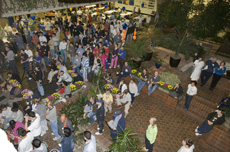
About 400 people gathered in Fermilab's atrium early Wednesday morning to witness the injection of the first beam of protons into the LHC.
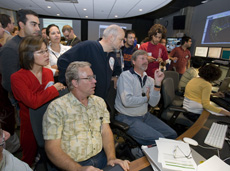
Fermilab Deputy Director Young-Kee Kim and Director Pier Oddone look over the shoulders of Fermilab accelerator scientists Eric Prebys and Elvin Harms at a monitor displaying the beam orbit in the LHC.
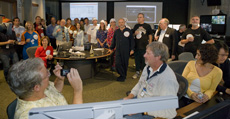
Fermilab Director Pier Oddone waits to speak with CERN Director General Robert Aymar after the first beam injection early Wednesday morning.
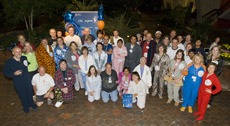
A group of pajama-clad Fermilab employees and physics enthusiasts poses for a group photo Wednesday, during the pajama party.
|
LHC first beam coverage

Google included a representation of the LHC first beam event on their general Web site. Media and public interest in the LHC first beam event brought down both the CERN and US LHC Web sites for periods this morning. At time of publication, a Google News search for the LHC returned more than 3,500 hits.
Editor's Note: Interest in the LHC first beam event by public and the media was so strong that it was the top news story of the morning. For those who couldn't make the 1:30 a.m. event, or those who may want to relive the excitement, a selection of blog posts from Fermilab's Pajama Party and science enthusiasts across the world is available below.
From symmetry breaking, Sept. 10, 2008
Sept. 10, 2008, Fermilab in Batavia, Illinois, home to the remote operations center for the CMS experiment at CERN.
2 a.m. Herman White, Fermilab scientist and host for the night, steps up to the microphone in front of a crowd of about 400 scientists, technicians, journalists, politicians and students - many sporting pajamas or the odd nightcap. With our host mid-sentence, a counter appears on the screen streaming video from CERN, the European high-energy physics laboratory on the Franco-Swiss border. A group countdown begins.....
.... 2:15 a.m. Jim Kerby, who works in the technical division at Fermilab, searches for familiar faces on the video feed. He returned last month from a year in Switzerland working as leader of the U.S. LHC Project. No one can predict exactly how the test beam will work, he said.
"Even if individually, all those pieces are relatively well understood," he said, "you can take individually very simple things then put them all together, and you get a very complicated thing."
2:34 a.m. "We've got beam!" the announcer says on the live feed. The researchers at CERN plan to guide the beam gradually around the accelerator ring, blocking it briefly at several stopping points before letting it pass.
-- Kathryn Grim
Read more
Other blogs about the event:
About a dozen students participating in the QuarkNet program attended the event and blogged about it. You can read their blogs here.
View Computing Division employee Wayne Baisley's blog about the event here.
Read the LHC bloggers' take on the event here.
Read a live blog from the event by SLAC's David Harris here.
|
|
|
All welds are not equal.
Giorgio Apollinari, head of the Technical Division, wrote this week's column.
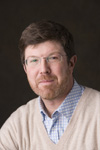 |
| Giorgio Apollinari |
It is human nature to focus on big goals and major achievements, such as the startup of the LHC, and to forget the "nitty-gritty" details that make large endeavors possible. But simple things, such as the specification of a particular weld, often determine whether a project meets its deadlines or a scientific instrument performs as specified.
The importance of such simple things became clear during an engineering review of a Fermilab-built cryomodule destined to operate at DESY in Hamburg. Since 2001, Fermilab has worked on the design and assembly of a 3.9 GHz cryomodule for DESY's free-electron laser. Before we can ship the equipment to DESY, we need to certify that various components of the cryomodule meet the code of the American Society of Mechanical Engineers and the DOE safety regulation requirement 10 CFR 851, established in 2006. The ASME code is the U.S. national code that regulates the assembly and use of materials in vacuum and pressure vessel applications.
In the last months, several AD and TD engineers have worked on the engineering and safety documentation for this cryomodule. In this process, they found some welds that-although safe under operating conditions-did not have the documents to certify the welds appropriately. This simple oversight in the planning process delayed the approval. At the same time, the hiccup highlighted the exemplary efforts by the Fermilab machine shop to keep its welding program up to date.
The Fermilab welding program is one of many treasures of our laboratory. Since the 1970s, the machine shop has developed and maintained a set of welding qualifications. Our welders maintain their qualifications by executing specific welds on a periodic basis. In 2006 and 2007 the Machine Shop Department identified 18 new types of welds to be added to the list of qualifications to comply with the new 10 CFR 851 regulation. Since then we have been executing a program to qualify our individual welders on each of these welds. Planning ahead and properly documenting the certification of more types of welds will speed up future engineering reviews like the ones needed for the Project X cryomodules.
Certification requirements and quality assurance need to be part of every project from the very beginning, even for "simple" things. They help us achieve our goals in a better and safer way.
|
CERN launches particle collider
From New York Times, Sept. 10, 2008
BATAVIA, ILL. - Science rode a beam of subatomic particles and a river of champagne into the future on Wednesday.
After 14 years and $8 billion, scientists at the European Center for Nuclear Research, or CERN, outside Geneva, succeeded in turning on the most powerful microscope ever built for investigating the elemental particles and forces of nature.
At 4:27 a.m., Eastern time, the protons made their first circuit around a 17-mile-long racetrack known as the Large Hadron Collider, 300 feet underneath the Swiss French border, and then made a return journey.
"It's a fantastic moment," said Lyn Evans, who has been the project director of the collider since its inception. "We can now look forward to a new era of understanding about the origins and evolution of the universe."
An ocean and half a continent away from Geneva, several dozen physicists, journalists, students and just plain citizens gathered here at the Fermi National Accelerator Laboratory, or Fermilab, outside Chicago, to watch the dawn of a new generation in high-energy physics, applauding each milestone of the night as the scientists at CERN slowly wrestled the beam into shape.
Dr. Pier Oddone, Fermilab's director, lauded the new machine as the result of "two and a half decades of dreams to open up this huge new territory in the exploration of the natural world."
Read more
Read the Beacon News story
|
ES&H weekly report, Sept. 9
This week's safety report, compiled by the Fermilab ES&H section, lists two minor incidents, neither one recordable. We have now worked 20 days since the last reportable incident. Find the full report here.
Safety report archive
|
|
Have a safe day!
URA Visiting Scholars Program applications due today
The application deadline for the next round of scholarships for the Universities Research Association's Visiting Scholars Program is Sept. 10. The program will support visits by researchers from URA member institutions to work at Fermilab for periods of up to one year. More information.
Argentine Tango lessons offered
Argentine Tango lessons are offered every Wednesday in Ramsey Auditorium at 7:30 p.m. for beginners and 8:30 p.m. for
intermediate/advanced level. Classes are taught by Daniel Noce and Ramona Nita, $15 per person per class. E-mail Pamela Noyes to sign up.
September Wilson Hall Window washing
Window washing of Wilson Hall's exterior windows will continue through Friday. Wilson Hall interior window washing will begin on Monday and continue through Thursday. The schedule is below. Please clear all items from in front of windows prior to your floor's interior washing date.
Wednesday: Floors 4-7
Thursday: Ground, Mezannine and floors 1-3.
Megafloods lecture Sept. 12
Megafloods are the largest known freshwater floods with flows comparable in scale to ocean currents. They are capable of inducing global changes in climate. Fermilab Lecture Series will present a lecture on these floods by Dr. Victor Baker from the University of Arizona on Friday, Sept. 12, at 8 p.m. Tickets are $5. More information.
Mathematica 6 software in library
Wolfram's Mathematica 6 software is now loaded on one computer in the Fermilab Library on the 3rd floor of Wilson Hall. Anyone at Fermilab is welcome to use it. Please bring a thumb or flash drive if you would like to save your work. The library also has a circulating collection of books about Mathematica and a subscription to the journal Mathematica. Learn more.
Additional Activities
|
|